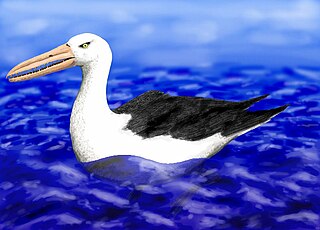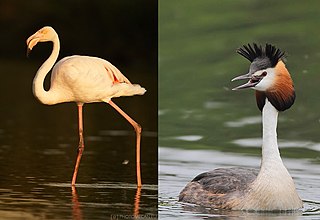
Charadriiformes is a diverse order of small to medium-large birds. It includes about 390 species and has members in all parts of the world. Most charadriiform birds live near water and eat invertebrates or other small animals; however, some are pelagic (seabirds), others frequent deserts, and a few are found in dense forest. Members of this group can also collectively be referred to as shorebirds.

Grebes are aquatic diving birds in the order Podicipediformes. Grebes are widely distributed freshwater birds, with some species also found in marine habitats during migration and winter. Most grebes fly, although some flightless species exist, most notably in stable lakes. The order contains a single family, the Podicipedidae, which includes 22 species in six extant genera.

Flamingos or flamingoes are a type of wading bird in the family Phoenicopteridae, which is the only extant family in the order Phoenicopteriformes. There are four flamingo species distributed throughout the Americas, and two species native to Afro-Eurasia.

Phoenicopteriformes is a group of water birds which comprises flamingos and their extinct relatives. Flamingos and the closely related grebes (Podicipedidae) are contained in the parent clade Mirandornithes.

The mousebirds are birds in the order Coliiformes. They are the sister group to the clade Cavitaves, which includes the Leptosomiformes, Trogoniformes (trogons), Bucerotiformes, Piciformes and Coraciformes. This group is now confined to sub-Saharan Africa, and it is the only bird order confined entirely to that continent, with the possible exception of turacos which are considered by some as the distinct order Musophagiformes, and the cuckoo roller, which is the only member of the order Leptosomiformes, and which is found in Madagascar but not mainland Africa. Mousebirds had a wider range in the Paleogene, with a widespread distribution in Europe and North America during the Paleocene.

Palaelodus is an extinct genus of bird of the Palaelodidae family, distantly related to flamingos. They were slender birds with long, thin legs and a long neck resembling their modern relatives, but likely lived very different livestyles. They had straight, conical beaks not suited for filter feeding and legs showing some similarities to grebes. Their precise lifestyle is disputed, with researchers in the past suggesting they may have been divers, while more recent research suggests they may have used their stiff toes as paddles for swimming while feeding on insect larvae and snails. This behavior may have been key in later phoenicopteriforms developing filterfeeding bills. The genus includes between five and eight species and is found across Europe, Australia, New Zealand, Asia and possibly South America. However some argue that most of the taxa named from Europe simply represent differently sized individuals of one single species. Palaelodus was most abundant during the Late Oligocene to Middle Miocene periods, but isolated remains from Australia indicate that the genus, or at least a relative, survived until the Pleistocene.

Osteodontornis is an extinct seabird genus. It contains a single named species, Osteodontornis orri, which was described quite exactly one century after the first species of the Pelagornithidae was. O. orri was named after Santa Barbara Museum of Natural History paleontologist Phil C. Orr, for his recognition of the importance of the specimen.
Megapaloelodus is an extinct genus of stem flamingo of the family Palaelodidae. Megapaloelodus is primarily known from Miocene America, from South Dakota and Oregon in the north to Argentina in the south, but the species Megapaloelodus goliath was found in Europe. Additionally, one unnamed species was discovered in Miocene sediments from Namibia. Due to a lack of skull material, little can be said about the ecology of Megapaloelodus. Species of this genus are typically larger than those of Palaelodus and appear to have inhabited similar brackish lake environments. Additionally, they may have been capable of "locking" their legs in a standing position.
Polarornis is a genus of prehistoric bird, possibly an anserimorph. It contains a single species Polarornis gregorii, known from incomplete remains of one individual found on Seymour Island, Antarctica, in rocks which are dated to the Late Cretaceous.

The Pelagornithidae, commonly called pelagornithids, pseudodontorns, bony-toothed birds, false-toothed birds or pseudotooth birds, are a prehistoric family of large seabirds. Their fossil remains have been found all over the world in rocks dating between the Early Paleocene and the Pliocene-Pleistocene boundary.

John Alan Feduccia is a paleornithologist specializing in the origins and phylogeny of birds. He is S. K. Heninger Distinguished Professor Emeritus at the University of North Carolina. Feduccia's authored works include three major books, The Age of Birds, The Origin and Evolution of Birds, and Riddle of the Feathered Dragons.
Paleontology or palaeontology is the study of prehistoric life forms on Earth through the examination of plant and animal fossils. This includes the study of body fossils, tracks (ichnites), burrows, cast-off parts, fossilised feces (coprolites), palynomorphs and chemical residues. Because humans have encountered fossils for millennia, paleontology has a long history both before and after becoming formalized as a science. This article records significant discoveries and events related to paleontology that occurred or were published in the year 1987.
Paleontology or palaeontology is the study of prehistoric life forms on Earth through the examination of plant and animal fossils. This includes the study of body fossils, tracks (ichnites), burrows, cast-off parts, fossilised feces (coprolites), palynomorphs and chemical residues. Because humans have encountered fossils for millennia, paleontology has a long history both before and after becoming formalized as a science. This article records significant discoveries and events related to paleontology that occurred or were published in the year 1976.

Mirandornithes is a clade that consists of flamingos and grebes. Many scholars use the term Phoenicopterimorphae for the superorder containing flamingoes and grebes.

Dasornis is a genus of prehistoric pseudotooth birds. These were probably close relatives of either pelicans and storks or waterfowl; they are placed in the order Odontopterygiformes to account for this uncertainty.

Palaelodidae is a family of extinct birds in the group Phoenicopteriformes, which today is represented only by the flamingos. They were widespread during the Neogene, with fossil remains found on all continents other than Antarctica. The oldest remains referred to this group appeared in the fossil record during the Oligocene in Egypt and Belgium, before palaelodids reached their peak diversity during the Miocene. Following this the group declined in the early Pliocene before going extinct on most continents. However, remains found near Cooper Creek in the Lake Eyre Basin indicate that palaelodids managed to survive in Australia until the Pleistocene. Currently three genera are recognized by scientists: Adelalopus, Palaelodus and Megapaloelodus. Most fossil remains stem from Europe and have been assigned to the type species, Palaelodus ambiguus. Due to the fragmentary nature of most of these species, little is known about their ecology. They appear to have preferred brackish lakes and lagoons. Palaelodus has previously been thought to be a wader or diver, but recent research indicates that they were better suited for swimming and possibly fed on insect larvae and other aquatic invertebrates. At least Megapaloelodus appears to have adaptations for "locking" their legs in a standing position.
Harrisonavis is an extinct genus of flamingo that lived during the Late Oligocene and Early Miocene periods in what is now France. Despite being one of the oldest known members of the flamingo family, it already shows a skull remarkably similar to that of the modern greater flamingo. Although generally similar, it subtly differs in the curvature of the bill and the size of the ventral keel of the maxilla, both signs that Harrisonavis was not yet as adapted towards filter feeding as modern species are. Harrisonavis inhabited brackish lakes alongside the more basal Palaelodidae. It contains the single species Harrisonavis croizeti, first described in 1852.

Tonsala is an extinct genus of Plotopteridae, a family of flightless seabird similar in biology with penguins, but more closely related to modern cormorants. The genus is known from terrains dated from the Late Oligocene of the State of Washington and Japan.
Agnopterus is an extinct genus of stem-flamingo phoenicopteriform with fossil material from France, as well as possibly England, Kazakhstan, and Brazil. The holotype specimen for type species A. laurillardi is an incomplete distal tibiotarsus from Late Eocene gypsum from Paris; a coracoid, humeri, a scapula and perhaps a proximal femur have been recovered from Late Eocene to Early Oligocene of England to a possible second species, A. hantoniensis. Two additional species from the Late Oligocene-Early Miocene have been named as well. A. turgaiensis of Kazakhstan and A. sicki of Brazil. While all four species are considered to be close to the ancestry of flamingos, their exact relationships and placement as members of Agnopterus is uncertain.
Adelalopus is an extinct genus of palaelodid bird from the lowermost Oligocene of Belgium. It is the oldest member of its family and the largest known palaelodid from Europe, slightly larger than Megapaloelodus goliath. It contains a single species, Adelalopus hoogbutseliensis.















